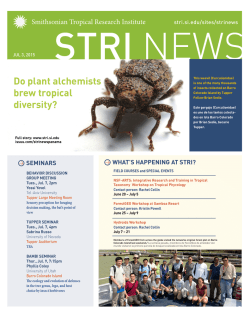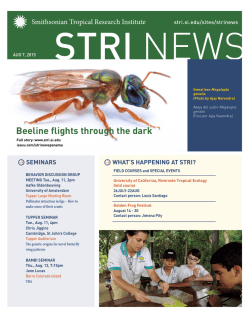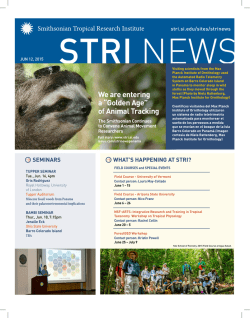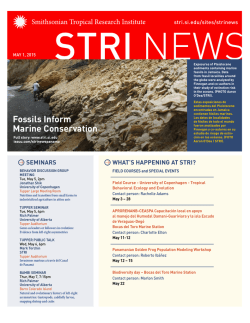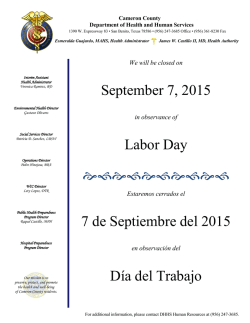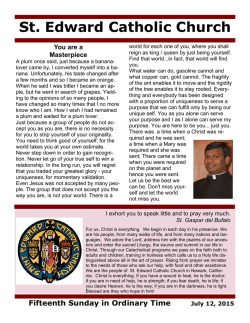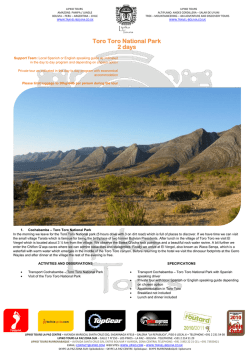
Colorful Caterpillar chemists may signal new useful plant compounds
stri.si.edu/sites/strinews OCT 2, 2015 Though caterpillars of the moth Periphoba arcaei will eat a wide variety of plants, they have also evolved a defense mechanism previously only seen in insects that specialize on eating toxic plants. They incorporate toxins from the tropical plant Vismia baccifera and advertise their unpalatability with brilliant green bodies covered in toxin-tipped hairs. A pesar de que las orugas de la polilla Periphoba arcaei se alimentan de una amplia variedad de plantas, estas han desarrollado un mecanismo de defensa que antes sólo se observaba en los insectos que se especializan en plantas tóxicas. Incorporan toxinas de la planta tropical Vismia baccifera y anuncian su sabor desagradable con suscuerpos de colores verde brillantes cubiertos de pelos con toxinas en las puntas. Colorful Caterpillar chemists may signal new Full story: www.stri.si.edu useful plant compounds issuu.com/strinewspanama/ SEMINARS BEHAVIOR DISCUSSION GROUP MEETING Tue., Oct. 6, 2pm Colin Morrison University of Nevada Tupper Large Meeting Room Why are tropical tortoise beetles such picky eaters? Testing the interaction between diet breadth, chemistry and natural enemies TUPPER SEMINAR Tue., Oct. 6, 4pm Robert Thacker Stony Brook University Tupper Auditorium Evolution of community structure in sponge microbiomes CHARLA DEL MES Wed. Oct. 7, 6pm Richard Cooke STRI Tupper Auditorium Historia ambiental y social de la Cuenca del Canal y alrededores, durante la Era Precolombina BAMBI SEMINAR Thu. Oct. 8, 7:15pm Daniel Buitrago STRI Barro Colorado Island A review of species limits in the Variable Mountain-Gem complex (Lampornis spp.) PUBLIC PROGRAMS / PROGRAMAS PÚBLICOS VISIT US / VISÍTENOS Barro Colorado / Isla Barro Colorado Contact / Contacto: 212-8951 Bocas del Toro Research Station / Estación de Investigación de Bocas del Toro Contact / Contacto: 212-8594 Galeta Point Marine Laboratory / Laboratorio Marino de Punta Galeta Contact / Contacto: 212-8191 Punta Culebra Nature Center / Centro Natural de Punta Culebra Contact / Contacto: 212-8793 OCEAN MONTH / MES DE LOS OCEANOS BEACH CLEANUP AT GALETA BEACH CLEANUP AT GALETA With over 200 volunteers participating from universities in Colon and Panama, Colegio Gatuncillo, Líderes en Acción group, partners and friends of Manzanillo International Terminal, family groups, and other volunteers; we cleaned the beach at Galeta. Garbage consisted mostly of plastic, followed by glass and aluminum and even an old refrigerator. We want to give special thanks to Manzanillo International Terminal, Aguaseo and Ancon for sponsoring snacks, gloves and bags for this activity. Con más de 200 participantes voluntarios de universidades de Colón y Panamá, el Colegio Gatuncillo, grupo Líderes en Acción, colaboradores y amigos de Manzanillo International Terminal, grupos familiares, entre otros; llevamos a cabo la limpieza de playa en Punta Galeta. La basura recogida consistió principalmente de plástico, seguido por vidrio y aluminio e increíblemente hasta una nevera vieja. Deseamos dar un especial agradecimiento a Manzanillo International Terminal, Aguaseo y Ancón por el patrocinio de los refrigerios, guantes y bolsas para el desarrollo de esta actividad. Images courtesy of Brais Marchena, volunteer at Galeta. Imágenes cortesía de Brais Marchena, voluntario en Punta Galeta. OCT 2, 2015 LITTERBUGS MESS UP REEFS Someone went to a lot of trouble to take two heavy plastic-and-aluminum deck chairs, hoist them onto a boat and dump them on the reef at Isla Grande, a popular beach destination along Panama’s Caribbean coast. Fortunately, a group of volunteer divers organized by Fundación Promar retrieved the chairs and 380kg of submerged garbage. The haul included more than 2,000 aluminum cans, 500 plastic objects and a car alternator. STRI staff scientist Aaron O’Dea, fellow Erin Dillon, and photographer Sean Mattson joined the almost 100 volunteers for the event. LOS COCHINOS ESTROPEAN LOS ARRECIFES Alguien se tomó el trabajo de llevar en bote y tirar dos pesadas sillas reclinables de plástico y aluminio en el arrecife de Isla Grande, un popular destino de playa que se encuentra a lo largo de la costa caribeña de Panamá. Afortunadamente, un grupo de buzos voluntarios, organizados por la Fundación Promar recuperaron las sillas y 380kg de basura sumergida. La colecta incluyó más de 2,000 latas de aluminio, 500 objetos de plástico y un alternador de auto. El científico del Smithsonian Aaron O’Dea, la becaria Erin Dillon, y el fotógrafo Sean Mattson se unieron a los casi 100 voluntarios del evento. OCT 2, 2015 FISHING INDUSTRY RESULTS IN STRI staff scientist Héctor Guzmán presented the results of a survey of different sectors of Panama’s fisheries community on Sept. 29. While an overwhelming majority 86.2 percent was in favor of passing a new fisheries law, 55.4 percent opposed new coastal marine protected areas (MPAs). The survey showed 49.2 percent were in favor of new MPAs for open waters. Conducted by the National Fishery Foundation, the goal of the 40-question survey is to inform decision makers and encourage the adpotion of new policies for sustainable fisheries. RESULTADOS DE LA ENCUESTA DE LA INDUSTRIA DE LA PESCA El 29 de septiembre, el científico del Smithsonian, Héctor Guzmán presentó los resultados de una encuesta realizada a los diferentes sectores de la comunidad pesquera de Panamá. Mientras que una abrumadora mayoría 86.2 por ciento estaba a favor de aprobar una nueva ley de pesca, el 55.4 por ciento se opuso a nuevas áreas protegidas marinocosteras. La encuesta mostró que un 49.2 por ciento estaba a favor de nuevas áreas marinas protegidas en aguas abiertas. Llevada a cabo por la Fundación Nacional de Pesca, el objetivo de la encuesta de 40 preguntas es para informar a los tomadores de decisiones y fomentar las nuevas políticas para la pesca sostenible. OCT 2, 2015 ART AND FORUM CLOSE OCEAN MONTH STRI hosted the closing forum for Panama’s Oceans Month at the Tupper Auditorium. Director Matt Larsen delivered opening remarks before presentations by Panama’s Ministry of the Environment and NGOs MarViva, Fundación Agua y Tierra, and Wetlands International. Awards were also given out to the schoolchildren who participated in Ocean Months’ annual art contest hosted by Promar and Banco Nacional. ARTE Y UN FORO DE CLAUSURA EN EL MES DE LOS OCÉANOS El Smithsonian fue anfitrión del foro de clausura en el Mes de los Océanos de Panamá que se llevó a cabo en el Auditorio Tupper. Matt Larsen, Director de la Institución pronunció las palabras de apertura ante presentantes del Ministerio de Ambiente de Panamá y las ONG MarViva, Fundación Agua y Tierra, y Wetlands International de Panamá. Los estudiantes que participaron en el concurso de arte anual del Mes de los Océanos organizado por Promar y el Banco Nacional recibieron premios. OCT 2, 2015 DEPARTURES ARRIVALS Benjamin Titus Ohio State University Comparative phylogeography in a multi-level sea anemone symbiosis: effects of host specificity on patterns of co-diversification and genetic biodiversity Bocas Del Toro Steffen Wolff University of Potsdam Ecosystem Services in the Panama Canal Watershed Agua Salud Adam Stuckert East Carolina University Signal modalities in an aposematic vertebrate Gamboa Emma Tomaszewski University of Chicago The Genomics of Speciation and Adaptation Gamboa Estefania Rodriguez American Museum of Natural History NSF-ARTS research and training in the systematics of Actiniaria Bocas Del Toro Robert Thacker State University of New York at Stony Brook NSF-ARTS Research and Training in the Systematics of Porifera sponges Bocas Del Toro Paris Morgan and Dipa Desai University of Florida PCP PIRE: Paleontology of the Canal of Panama Center for Tropical Paleoecology Colin Morrison University of Nevada Why are tropical tortoise beetles such picky eaters? Testing the interaction between diet breadth, chemistry and natural enemies Gamboa and Tupper Saskia Santamaria To the Azuero Peninsula To visit research/training sites and provide Leadership Program follow-up Jacob Slusser To Pedasi, Los Santos To visit research sites and provide follow up with Leadership Program Alumni Wendy Jimenez, Corina Guardia and Dalys Espinoza To Bocas Del Toro and David Site visit to Bocas installations for meetings Raul De León To Bocas Del Toro For equipment maintenance, compressor service and a checkout dive Juan Maté To Valparaiso, Chile To attend the “Our Ocean II” Conference Jefferson Hall To Front Royal, VA To participate in a Science Advisory Meeting on the Virginia’s Changing Landscapes initiative being run out of Smithsonian Conservation Biology Institute (SCBI) Ana Endara To Bocas Del Toro To film taxonomy videos at the station Rachel Collin To Bocas Del Toro For the NSF-ARTS digital media workshop Rodolfo Flores, Alicia Ibáñez, Agustín Almanza and Madelaine Aguilar To Santiago de Veraguas To participate in a workshop on ICBG research at schools and University in Santiago de Veraguas Carlos Jaramillo To Tunja, Colombia To give a speech at the National Evolution of Ecology and Environment Symposium PUBLICATIONS Bennett, A. C., McDowell, N. C., Allen, C. D. and Anderson-Teixeira, K. 2015. Larger trees suffer most during drought in forests worldwide. Nature Plants, doi:10.1038/ nplants.2015.139 Krüger, M., Teste, F. P., Laliberté, E., Lambers, H., Coghlan, M., Zemunik, G. and Bunce, M. 2015. The rise and fall of arbuscular mycorrhizal fungal diversity during ecosystem retrogression. Molecular ecology, doi:10.1111/mec.13363 Brown, G. P., Kelehear, C., Pizzatto, L. and Shine, R. 2015. The impact of lungworm parasites on rates of dispersal of their anuran host, the invasive cane toad. Biological Invasions, doi:10.1007/s10530-015-0993-1 Leigh, E. G., Jr. 2015. [Review]: Jean Pierre Changeux on how and why our brains enable us to make judgments about what is good, true or beautiful. Evolution: Education and Outreach, 8: 18-23. doi:10.1186/s12052-015-0045-4 Charbonnier, J. F. and Vonesh, J. R. 2015. Consequences of life history switch point plasticity for juvenile morphology and locomotion in the Túngara frog. PeerJ, 3: e1268doi:10.7717/peerj.1268 Mendieta-Leiva, G. and Zotz, G. 2015. A conceptual framework for the analysis of vascular epiphyte assemblages. Perspectives in Plant Ecology, Evolution and Systematics, doi:10.1016/j.ppees.2015.09.003 Farine, D. R., Montiglio, P.and Spiegel, O. 2015. From Individuals to Groups and Back: The Evolutionary Implications of Group Phenotypic Composition. Trends in Ecology & Evolution, 30(10): 609-621. doi:10.1016/j.tree.2015.07.005 Spalding, A. K., Suman, D. O. and Mellado, M. E. 2015. Navigating the evolution of marine policy in Panama: Current policies and community responses in the Pearl Islands and Bocas del Toro Archipelagos of Panama. Marine Policy, 62: 161-168. doi:10.1016/j.marpol.2015.09.020 Fung, T., Villain, L. and Chisholm, R. A. 2015. Analytical formulae for computing dominance from species-abundance distributions. Journal of theoretical biology, doi:10.1016/j.jtbi.2015.09.011 Green, P. A. and Patek, S. N. 2015. Contests with deadly weapons: telson sparring in mantis shrimp (Stomatopoda). Biology Letters, 11: 2015558 doi:10.1098/ rsbl.2015.0558 Supple, M. A., Papa, R., Hines, H. M., McMillan, W. O. and Counterman, B. A.2015. Divergence with gene flow across a speciation continuum of Heliconius butterflies. BMC Evolutionary Biology, 15(1): 204 doi:10.1186/s12862-015-0486-y Tschapka, M., Gonzalez-Terrazas, T. and Knornschild, M. 2015. Nectar uptake in bats using a pumping-tongue mechanism. Science Advances, 1: e1500525doi:10.1126/ sciadv.1500525 OCT 2, 2015 GET IN TOUCH! WE’D LOVE TO KNOW WHAT YOU THINK: ¡CONTÁCTANOS! NOS ENCANTARÍA SABER SU OPINION:
© Copyright 2025
